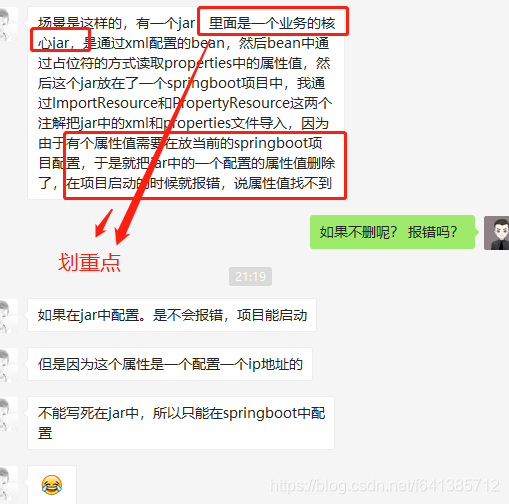#### 每篇一句
> 大师都是偏执的,偏执才能产生力量,妥协是没有力量的。你对全世界妥协了你就是空气。所以若没有偏见,哪来的大师呢
#### 相关阅读
[【小家Spring】详解PropertyPlaceholderConfigurer、PropertyOverrideConfigurer等对属性配置文件Properties的加载和使用](https://blog.csdn.net/f641385712/article/details/91444601)
[【小家Spring】Spring中@PropertySource和@ImportResource的区别,以及各自的实现原理解析](https://blog.csdn.net/f641385712/article/details/90636649)
[【小家Spring】Spring中@Value注解有多强大?从原理层面去剖析为何它有如此大的“能耐“](https://blog.csdn.net/f641385712/article/details/91043955)
---
对Spring感兴趣可扫码加入wx群:`Java高工、架构师3群`(文末有二维码)
---
#### 前言
写这篇文章的原动力是由于**昨晚深夜**一个小伙伴咨询我的一个问题(这位小伙伴这么晚了还在折腾,也是给个大大的赞),涉及到了如题方面的知识。
当然促使我书写本文最重要原因的是:这种从传统`Spring`项目向`SpringBoot`迁移进阶的case,我个人认为在现阶段的环境下还是有**较大概率**出现的,**因此推荐收藏本文,对你后续或许有所帮助~**
### 情景描述
为了更直观的说明问题所在,截图部分聊天记录如下:

**这位小伙伴描述的问题还是蛮清晰,所以我还是很愿意跟他一起探讨的~**
勾起兴趣还有一个原因:`Spring`对占位符提供了非常强大的支持,**但基本上新手**都还不能好好利用它和利用好它,更区分不清使用的规范和区别,本文也希望做点努力,能够起到稍微一点的作用~
对此部分内容若需要`热场`,推荐可以先浏览一下这篇文章:[【小家Spring】Spring中@PropertySource和@ImportResource的区别,以及各自的实现原理解析](https://blog.csdn.net/f641385712/article/details/90636649) 可以看到,早在我这篇文章里我就说了这么一句话:

而刚好这个小伙伴的场景(其实我自己还并没有遇到过此场景),就类属于`老项目`到`SpringBoot新项目`的一个迁移case,这时不结合分析,更待何时呢。
> 看到聊天记录,部分小伙伴可能会想:把Bean拿出来配置不就行了吗?或者key就写在原来的属性文件里呗?
> 其实对于职场老兵都能对此种现象给与理解和接受,毕竟有种叫**理想化**,有种叫是叫**实际化**~
---
---
---
因为我不可能贴出该小伙伴的源码(毕竟人家是生产环境的代码,咋可能贴出给大伙看呢?)so,接下来旨在说明这个问题,我就只好采用我的**模拟大法**喽:
#### 传统Spring工程下使用
本处以一个传统的Spring工程为例,模拟这种使用case。`classpath`下有如下两个文件:
**spring-beans.xml:**
```xml
```
可以看到此xml配置Bean中使用了占位符:`${diy.name}`来引用下面属性文件的属性值~
**my.properties:**
```java
diy.name = fsx-fsx
```
使用`@ImportResource`和`@PropertySource`分别把它哥俩导入:
```java
@ImportResource(locations = "classpath:spring-beans.xml")
@PropertySource("classpath:my.properties")
@Configuration
public class RootConfig {
}
```
运行如下测试用例:
```java
@RunWith(SpringJUnit4ClassRunner.class)
@ContextConfiguration(classes = {RootConfig.class})
public class TestSpringBean {
@Autowired
private ApplicationContext applicationContext;
@Autowired
private Environment environment;
@Test
public void test1() {
Person bean = (Person) applicationContext.getBean("myPerson");
System.out.println(bean);
System.out.println(environment.getProperty("diy.name"));
}
}
```
打印结果为:
```java
Person{name='${diy.name}', age=18}
fsx-fsx
```
从结果中可以至少知道如下两点:
1. 环境变量里是存在`diy.name`这个属性k-v的。并且此处我附上截图如下:

2. xml中的占位符**并没有**被解析
> 若你对技术有敏感性的话,你会疑问**为何占位符没被解析但并没有报错呢?**
> 这个问题我在这篇文章:[【小家Spring】Spring中@Value注解有多强大?从原理层面去剖析为何它有如此大的“能耐“](https://blog.csdn.net/f641385712/article/details/91043955) 里有过解释,有兴趣的可以点开看看(没兴趣的可以略过)
**存在但又没被解析,看似有点矛盾,难道Spring工程不支持这么用,作为职场老兵的你,答案肯定是否定的,那如何破呢?**
其实解决起来非常简单,我们只需要配置上一个`PropertyResourceConfigurer`即可:
```java
@Bean
public PropertyResourceConfigurer propertyResourceConfigurer() {
PropertyResourceConfigurer configurer = new PropertySourcesPlaceholderConfigurer();
// 使用的PropertySourcesPlaceholderConfigurer,不用自己再手动指定亦可处理占位符~~~
// configurer.setLocation(new ClassPathResource("my.properties")); // 加载指定的属性文件
return configurer;
}
```
再次运行,打印如下:
```java
Person{name='fsx-fsx', age=18}
fsx-fsx
```
**完美~**
关于xml配置Bean处理占位符问题,为了加深理解,亦可参考:[【小家Spring】Spring IoC是如何使用BeanWrapper和Java内省结合起来给Bean属性赋值的](https://blog.csdn.net/f641385712/article/details/91444601)
> 我想说:此处介绍的是注解版怎么处理占位符问题,若你仍旧是传统的xml配置项目,至于具体使用哪个标签,小伙伴自行寻找咯~
---
我们知道`PropertyResourceConfigurer`它是个抽象类,它的三大实现子类除了上例使用的,还有其余两大实现类:`PropertyOverrideConfigurer`和`PropertyPlaceholderConfigurer`,**若注册它哥俩可行吗???** 行不行试试呗
###### 使用PropertyOverrideConfigurer
`PropertyOverrideConfigurer` 利用属性文件的相关信息,覆盖XML 配置文件中`Bean定义`。它要求配置的属性文件第一个`.`前面是`beanName`来匹配,所以这个子类我看都不用看,它肯定不行(因为它改变了k-v的结构)。
> **其实上面说配置`PropertyResourceConfigurer`的实现类来处理是不太准确的。
> 准确的说应该是配置`PlaceholderConfigurerSupport`的实现子类来处理`Placeholder占位符`更精确,特此纠正哈~**
###### 使用PropertyPlaceholderConfigurer
其实大多数小伙伴对`PropertyPlaceholderConfigurer`比对`PropertySourcesPlaceholderConfigurer`熟悉多了,毕竟前者的`年纪`可大多了~
它哥俩都是`PlaceholderConfigurerSupport`的实现子类有能力能够处理占位符
> `PropertySourcesPlaceholderConfigurer`是Spring 3.1后提供的,希望用来取代`PropertyPlaceholderConfigurer`
```java
@Bean
public PropertyResourceConfigurer propertyResourceConfigurer() {
PropertyResourceConfigurer configurer = new PropertyPlaceholderConfigurer();
//configurer.setLocation(new ClassPathResource("my.properties")); // 加载指定的属性文件
return configurer;
}
```
运行上面用例就报错了:
```java
Caused by: java.lang.IllegalArgumentException: Could not resolve placeholder 'diy.name' in value "${diy.name}"
at org.springframework.util.PropertyPlaceholderHelper.parseStringValue(PropertyPlaceholderHelper.java:172)
at org.springframework.util.PropertyPlaceholderHelper.replacePlaceholders(PropertyPlaceholderHelper.java:124)
```
what?看打印结果,明明`environment.getProperty("diy.name")`从环境里能拿到这个key呀,怎么会报错呢???
这就是为何`Spring3.1`要提供一个`PropertySourcesPlaceholderConfigurer`旨在想代替掉此类的原因了。
**但是,但是,但是把上配置中注掉的那行代码放开(也就是说自己设置location从而把属性文件加载进来),就能正常work了。**
关于使用这种方式我还**有必要再说明一点**:若自己设置了location加载属性文件,`@PropertySource("classpath:my.properties")`这句代码对此种场景就没有必要了,`xml`配置的占位符也是能够读取到的。**但是但是但是**,若注掉这句`@PropertySource...`,此时运行输出如下:
```java
Person{name='fsx-fsx', age=18}
null
```
会发现`environment.getProperty("diy.name")`为null,也就是说该属性值并不会存在应用的环境内了(但是xml的占位符已被成功解析)。从我的这个截图中也能看出来环境里已经没它了:

至于这**深处**到底是什么原因,有兴趣的可以轻点这里:[【小家Spring】详解PropertyPlaceholderConfigurer、PropertyOverrideConfigurer等对属性配置文件Properties的加载和使用](https://blog.csdn.net/f641385712/article/details/91444601)
==只new一个PropertyPlaceholderConfigurer报错原因分析:==
其实从源代码处一眼就能看出来原因:
```java
public class PropertyPlaceholderConfigurer extends PlaceholderConfigurerSupport {
...
// 是否能被解析到值,重点在于入参的这个Properties props是否有这个key,而这个参数需要追溯它的父类~
@Override
protected void processProperties(ConfigurableListableBeanFactory beanFactoryToProcess, Properties props) throws BeansException {
StringValueResolver valueResolver = new PlaceholderResolvingStringValueResolver(props);
doProcessProperties(beanFactoryToProcess, valueResolver);
}
...
}
// 从父类中看看props的传值是啥~~~
public abstract class PropertyResourceConfigurer extends PropertiesLoaderSupport implements BeanFactoryPostProcessor, PriorityOrdered {
...
@Override
public void postProcessBeanFactory(ConfigurableListableBeanFactory beanFactory) throws BeansException {
try {
Properties mergedProps = mergeProperties();
// Convert the merged properties, if necessary.
convertProperties(mergedProps);
// Let the subclass process the properties.
// 抽象方法,交给子类~~~这里传入的mergedProps,全部来自location~~~
processProperties(beanFactory, mergedProps);
} catch (IOException ex) {
throw new BeanInitializationException("Could not load properties", ex);
}
}
protected Properties mergeProperties() throws IOException {
...
loadProperties(result);
...
}
// 从配置里的location里把属性值都读出来~~~~~
protected void loadProperties(Properties props) throws IOException {
if (this.locations != null) {
for (Resource location : this.locations) {
...
PropertiesLoaderUtils.fillProperties(props, new EncodedResource(location, this.fileEncoding), this.propertiesPersister);
...
}
}
}
...
}
```
由此可见,若上述`@Bean`配置使用的是`PropertyPlaceholderConfigurer`,那必须手动的把属性文件设置location加载进去才行,**否则是读取不到滴~**
==那么问题来了,为何使用PropertySourcesPlaceholderConfigurer,只需要简单的new一个就成了勒(并不需要手动设置location)?==
一样的,从源码处一看便知,非常非常简单:
```java
// @since 3.1 直接实现了EnvironmentAware,说明此Bean可以拿到当前环境Environment
public class PropertySourcesPlaceholderConfigurer extends PlaceholderConfigurerSupport implements EnvironmentAware {
...
@Override
public void postProcessBeanFactory(ConfigurableListableBeanFactory beanFactory) throws BeansException {
...
// 把环境属性都放进来~
if (this.environment != null) {
this.propertySources.addLast(
new PropertySource(ENVIRONMENT_PROPERTIES_PROPERTY_SOURCE_NAME, this.environment) {
@Override
@Nullable
public String getProperty(String key) {
return this.source.getProperty(key);
}
}
);
}
// 把配置的属性放进来~~~
PropertySource localPropertySource = new PropertiesPropertySource(LOCAL_PROPERTIES_PROPERTY_SOURCE_NAME, mergeProperties());
this.propertySources.addFirst(localPropertySource);
...
}
}
```
相信不用我做过多的解释,就知道为何不用自己设置location,直接使用注解`@PropertySource("classpath:my.properties")`就好使了吧。这个时候环境截图如下(**注意:此处我截图是基于`已经set了location`的截图哦**):

what?虽然配置时候set了location去加载属性文件,但是上面代码中add进去的属性源`environmentProperties`和`localProperties`
```java
public static final String LOCAL_PROPERTIES_PROPERTY_SOURCE_NAME = "localProperties";
public static final String ENVIRONMENT_PROPERTIES_PROPERTY_SOURCE_NAME = "environmentProperties";
```
两个`PropertySource`都并没有出现?
关于此,我这里就不再解释了,哈哈。还是那句话,**留给小伙伴们自己思考**,若思考不明白的亦可扫码入群探讨哦~(当然参照上面文章也是可行的)
---
#### SpringBoot工程下使用
关于在`SpringBoot`中使用,简单到令人发指,毕竟`SpringBoot`的使命也是让你使用它能够简单到木有朋友。
so,在`SpringBoot`工程下使用`@ImportResource`和`@PropertySource`啥都不用配,它是能够天然的直接work的~
==原因分析如下:==
一切得益于`SpringBoot`强悍的自动化配置能力,它提供了这样一个配置类:
```java
@Configuration
@AutoConfigureOrder(Ordered.HIGHEST_PRECEDENCE) // 最高优先级
public class PropertyPlaceholderAutoConfiguration {
// 注意此处使用的是PropertySourcesPlaceholderConfigurer
// 并且你可以在本容器内覆盖它的默认行为哟~~~~
@Bean
@ConditionalOnMissingBean(search = SearchStrategy.CURRENT)
public static PropertySourcesPlaceholderConfigurer propertySourcesPlaceholderConfigurer() {
return new PropertySourcesPlaceholderConfigurer();
}
}
```
`PropertyPlaceholderAutoConfiguration`它被配置在了自动配置包下的`spring.factories`文件里:
```java
# Auto Configure
org.springframework.boot.autoconfigure.EnableAutoConfiguration=\
...
org.springframework.boot.autoconfigure.context.PropertyPlaceholderAutoConfiguration,\
...
```
因此它会随着工程启动而自动生效。有了上面对`Spring`工程下的使用分析,此处就**不用再**花笔墨解释了~
**另外附加说明一点:哪怕你的属性不使用`@PropertySource`导入,而是写在`SB`自带的`application.properties`文件里,依旧是没有问题的。**
==原因分析如下:==
其实这个涉及到的是`SpringBoot`对`application.properties`的加载时机问题,因为本文对`SB`的介绍并不是重点,因此此处我直接**简单的说出结论**即止:
- `SpringBoot`通过事件监听机制加载很多东西,加载此属性文件用的是`ConfigFileApplicationListener`这个监听器
- 它监听到`ApplicationEnvironmentPreparedEvent`(环境准备好后)事件后开始加载`application.properties`等文件
- `ApplicationEnvironmentPreparedEvent`的事件发出是发生在`createApplicationContext()`之前~~~ 部分代码如下:
```java
public class SpringApplication {
...
public ConfigurableApplicationContext run(String... args) {
...
ApplicationArguments applicationArguments = new DefaultApplicationArguments(args);
// 此步骤 会发出ApplicationEnvironmentPreparedEvent事件
ConfigurableEnvironment environment = prepareEnvironment(listeners, applicationArguments);
Banner printedBanner = printBanner(environment);
// 开始创建,初始化容器~
context = createApplicationContext();
...
}
...
}
```
so,在`SB`环境下已经早早把属性都放进环境内了,借助它默认配置好的`PropertySourcesPlaceholderConfigurer`来处理的,那可不能正常work吗。一切都是这么自然,**这或许就是`SB`的魅力所在吧~**
#### 关于小伙伴问题的解决
开头提出了问题,肯定得解决问题嘛~~~如下图

哈哈,虽然最终我并没有**直接的**帮助解决问题,但是此问题给了我写本文的动力,总体还是不错的~
#### 总结
本文通过一个小伙伴咨询的`小问题(真是小问题吗?)`引申比较详细的说了`Spring`在处理占位符这块的内容(其实本并没打算写这么多的,尴尬~)
写本文的目的开头也说了,我认为在`SpringBoot`还并非100%渗透的当下,肯定有人会遇到从传统`Spring`项目向`SpringBoot`过度的一个阶段,而本文的描述或许能给你的迁移提供一种新的思路(特别是时间紧、任务重的时候),希望小伙伴们能有所收获,peace~
#### 知识交流
> **`若文章格式混乱,可点击`**:[原文链接-原文链接-原文链接-原文链接-原文链接](https://blog.csdn.net/f641385712/article/details/96195401)
==The last:如果觉得本文对你有帮助,不妨点个赞呗。当然分享到你的朋友圈让更多小伙伴看到也是被`作者本人许可的~`==
**若对技术内容感兴趣可以加入wx群交流:`Java高工、架构师3群`。
若群二维码失效,请加wx号:`fsx641385712`(或者扫描下方wx二维码)。并且备注:`"java入群"` 字样,会手动邀请入群**

